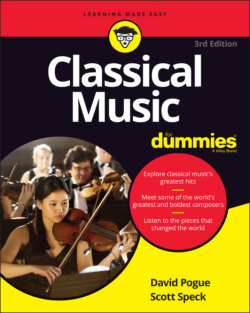Читать книгу Classical Music For Dummies - Scott Speck - Страница 3
Classical Music For Dummies® To view this book's Cheat Sheet, simply go to www.dummies.com and search for “Classical Music For Dummies Cheat Sheet” in the Search box. Table of Contents
Оглавление1 Cover
2 Title Page
3 Copyright
4 Introduction About This Book Foolish Assumptions Icons Used in This Book Beyond the Book Where to Go from Here
5 Part 1: Getting Started with Classical Music Chapter 1: Prying Open the Classical Music Oyster Discovering What Classical Music Really Is Figuring Out What You Like The Seven Habits of Highly Effective Composers Chapter 2: The Entire History of Music in 80 Pages Understanding How Classical Music Got Started Chanting All Day: The Middle Ages The First Composer-Saint Born Again: The Renaissance Getting Emotional: The Baroque Era Tightening the Corset: The Classical Style Falling in Love: Hopeless Romantics Saluting the Flag(s): Nationalism in Classical Music Listening to Music of the 20th Century and Beyond Chapter 3: Spotting a Sonata Symphonies Sonatas and Sonatinas Concertos Dances and Suites Serenades and Divertimentos Themes and Variations Fantasias and Rhapsodies Tone Poems (Or Symphonic Poems) Lieder (and Follower) Oratorios and Other Choral Works Operas, Operettas, and Arias Overtures and Preludes Ballets and Ballerinas String Quartets and Other Motley Assortments Why Do You Need a Form, Anyway?
6 Part 2: Listen Up! Chapter 4: Dave ’n’ Scott’s E-Z Concert Survival Guide™ Preparing — or Not Knowing When to Arrive at the Concert Can I Wear a Loincloth to The Rite of Spring? The Gourmet Guide to Pre-Concert Dining Figuring Out Where to Sit — and How to Get the Best Ticket Deals To Clap or Not to Clap: That’s the Question Who to Bring and Who to Leave at Home with the Dog Recognizing Which Concerts to Attend — or Avoid — on a Date Peeking at the Concert Program Introducing the Concertmaster Enter the Conductor Chapter 5: For Your Listening Pleasure 1 Handel: Water Music Suite No. 2: Alla Hornpipe 2 Bach: Well-Tempered Clavier, Book 2: Prelude and Fugue in C Major 3 Mozart: Piano Concerto No. 22 in E-Flat, Third Movement 4 Beethoven: Symphony No. 5, First Movement 5 Brahms: Symphony No. 4, Third Movement 6 Dvořák: Serenade for Strings, Fourth Movement 7 Tchaikovsky: Symphony No. 6, Fourth Movement 8 Debussy: La Mer: Dialogue du Vent et de la Mer 9 Stravinsky: The Rite of Spring: Opening to the End of Jeu de Rapt Intermission: Backstage Tour Living in the Orchestral Fishpond What I Did for Love Going through an Audition The Life of an Orchestra Musician, or What’s Going on in the Practice Room? Selling the Product Understanding Contract Riders The Strange and Perilous Relationship between an Orchestra and Its Conductor Why an Orchestra Career Is Worth the Grief
7 Part 3: A Field Guide to the Orchestra Chapter 6: Keyboards & Co. The Piano The Harpsichord The Organ The Synthesizer Chapter 7: Strings Attached The Violin The Other String Instruments Chapter 8: Gone with the Woodwinds The Flute The Piccolo The Oboe The English Horn The Clarinet The Saxophone The Bassoon Chapter 9: The Top (and Bottom) Brass Making a Sound on a Brass Instrument The French Horn The Trumpet The Trombone The Tuba Pet Peeves of the Brassily Inclined Chapter 10: Percussion’s Greatest Hits The Timpani The Bass Drum The Cymbals The Snare Drum The Xylophone Other Xylo-like Instruments More Neat Instruments Worth Banging
8 Part 4: Peeking into the Composer’s Brain Chapter 11: The Dreaded Music Theory Chapter I’ve Got Rhythm: The Engine of Music Understanding Pitch: Beethoven at 5,000 rpm Making the Leap into Intervals Getting on the Scale Constructing a Melody Getting Two-Dimensional: Piece and Harmony Put in Blender, Mix Well Getting Your Music Theory Degree Chapter 12: Once More, with Feeling: Tempo, Dynamics, and Orchestration Meet the Dynamics Duo: Soft and Loud Throwing Tempo Tantrums Telling ’Bones from Heckelphones: Orchestration Made Easy
9 Part 5: The Part of Tens Chapter 13: The Ten Most Common Misconceptions about Classical Music Classical Music Is Boring Classical Music Is for Snobs All Modern Concert Music Is Hard to Listen to They Don’t Write Classical Music Anymore You Have to Dress Up to Go to the Symphony If You Haven’t Heard of the Guest Artist, She Can’t Be Any Good Professional Musicians Have It Easy The Best Seats Are Down Front Clapping between Movements Is Illegal, Immoral, and Fattening Classical Music Can’t Change Your Life Chapter 14: The Ten Best Musical Terms for Cocktail Parties Atonal Cadenza Concerto Counterpoint Crescendo Exposition Intonation Orchestration Repertoire Rubato Tempo Using Your New-Found Mastery Chapter 15: Ten Great Classical Music Jokes Master of Them All The Heavenly Philharmonic Brass Dates The Late Maestro Basses Take a Breather Houseless Violist Ludwig’s Grave The Weeping Violist Musicians’ Revenge One Last Viola Joke Chapter 16: Ten Ways to Get More Music in Your Life Get Involved with Your Orchestra Join a Classical Music Tour Meet the Artists — Be a Groupie Make Music Friends on the Internet Join an Unlimited Music Service Listen to Your Local Classical Station Load Up on Your Own Recordings Watch Classical Music Movies Study Up on the Classics Make Your Own Music
10 Part 6: The Appendixes Appendix A: Listen to This! Starting a Classical Music Collection List 1: Old Favorites List 2: MILD on the Taste Meter List 3: MEDIUM on the Taste Meter List 4: MEDIUM HOT on the Taste Meter List 5: HOT on the Taste Meter Appendix B: Classical Music Timeline Appendix C: Glossary
11 Index
12 About the Authors
13 Connect with Dummies
14 End User License Agreement
